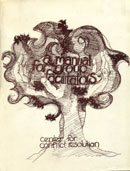

|
|

A Manual for Group Facilitators
Auvine, Brian; Densmore, Betsy; Extrom, Mary; Poole, Scott; Shanklin, Michel
Publisher: Center for Conflict Resolution, Madison, USAYear Published: 1977 Pages: 90pp Price: $7.95 ISBN: 0-941492-00 Resource Type: Pamphlet Cx Number: CX6370 Abstract: - Table of Contents Preface How to Use This Manual Glossary Chapter One Introduction: What We Means by Facilitation I. The Values We Stress II. What a Facilitator Does III. Code of Responsibilities: Ethics for Facilitators IV. Suggested Reading Chapter Two Homework I. Functions of Groups II. Scouting III. Negotiating IV. Planning the Session(s) Chapter Three Getting Started I. Before You Begin II. As You Enter the room III. Seating Arrangements IV. Introduction A. Your Introduction B. Introduction of the Group V. Clarifying Roles A. Demystifying the Facilitator B. The Recorder C. The Participants D. Altering the Roles VI. Agreeing on Plans A. Expectations B. Agenda Review VII. Cycles Groups Go Through VIII. General Comments Chapter Four Group Process I. Communication A. Adapt to Your Listeners B. Listening is Important C. Be aware of What is Happening in the Group D. Test Assumptions E. Give Feedback F. How You Talk Patterns How Others Respond II. Phrasing Questions III. Facilitating Discussions A. Getting Things Rolling B. Facilitating During the Discussion IV. Group Dynamics A. Size of the Group B. Cooperation vs. competition C. Leadership D. Scapegoating V. Rules for Using Exercises VI. Suggested Reading Chapter Five Special Techniques I. Facilitating Films II. Thinking as a Group A. Brainstorming B. Nominal Group Technique III. The Recorder IV. Team Facilitation Techniques V. Conflict Resolution A. Types of Behavior in Conflicts B. Diagnosis C. Dealing with the Conflict VI. Crisis intervention A. Deciding Whether to Intervene B. Your Role in Intervention VII. Problem Solving A. Before You Attempt Problem Solving B. The Process of Problem Solving C. Special Note on "Personality Problems" VIII. Suggested Reading Chapter Six Evaluation I. Definition and Function II. How to Handle an Evaluation A. Times for Evaluation B. Conducting the Evaluation C. Forms of Evaluation III. Use the Evaluation to Improve You Facilitation the Next Time Chapter Seven What Can Go Wrong: What to Do About It I. When People are not Participating or When They Appear Bored II. When People Come Down on the Facilitator III. When There isn't Enough Time to do What You Had Planned IV. When There is More Time Than You Had Planned For V. When Arguments Break Out in the Group VI. When Not Enough or Too Many People Show Up VII. When Facilities Aren't Good For What You are Doing VIII. What Do You Do About Your Own Feelings? IX. Voyeurs and Flashers X. When an Exercise Flops XI. When Some Participants Cause Interruptions XII. Mistaken Expectations - When You Have Been Misrepresented to the Group, or the Group to You XIII. Your Material is Too Simple or Too Complex for the Group XIV. Someone "Freaks Out" XV. Summary Appendix A Finding Facilitation Training Courses Appendix B Sample Agendas Appendix C The UGLI Orange Exercise Appendix D Sources of Exercises Footnotes Subject Headings |